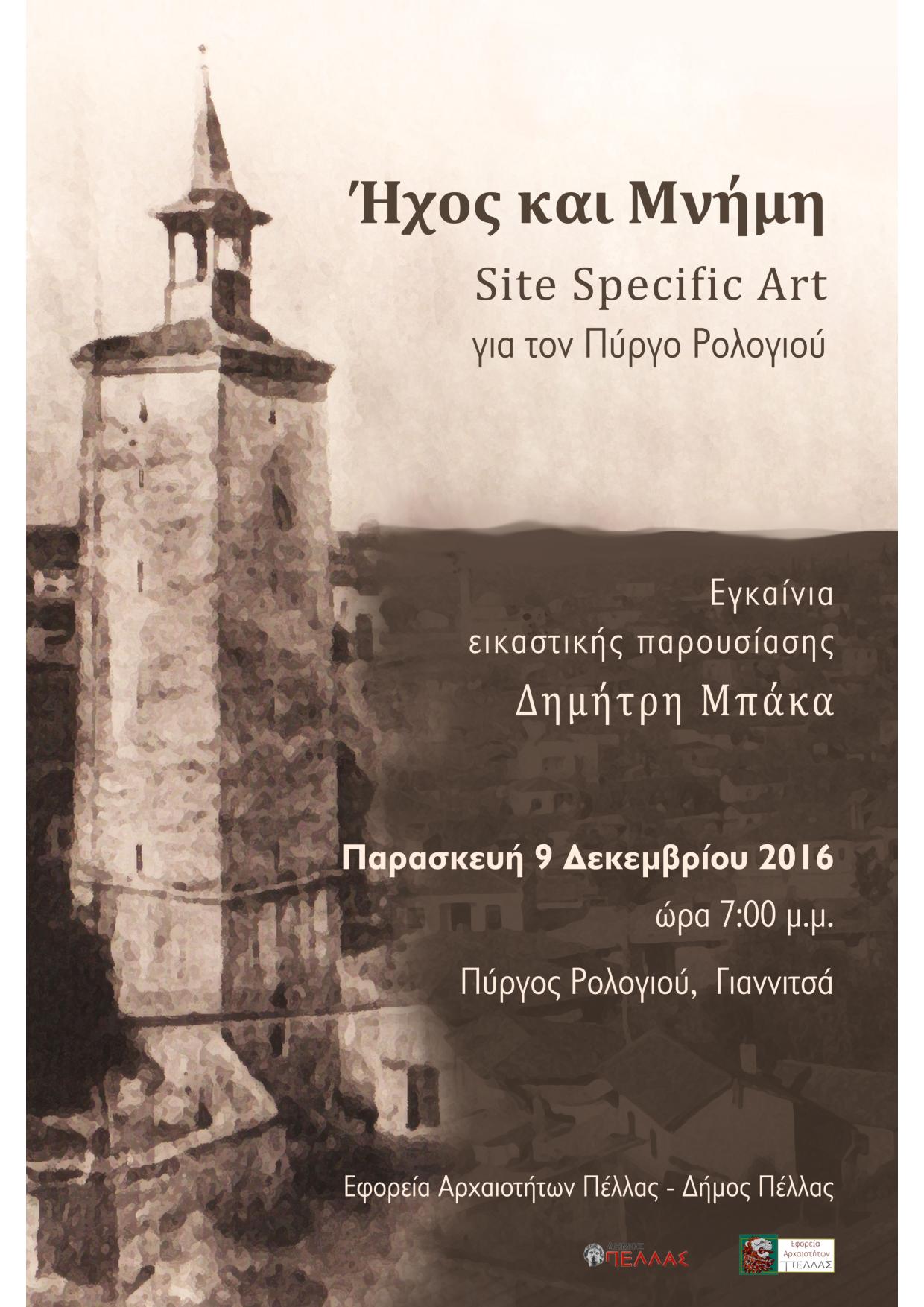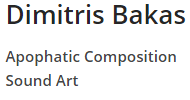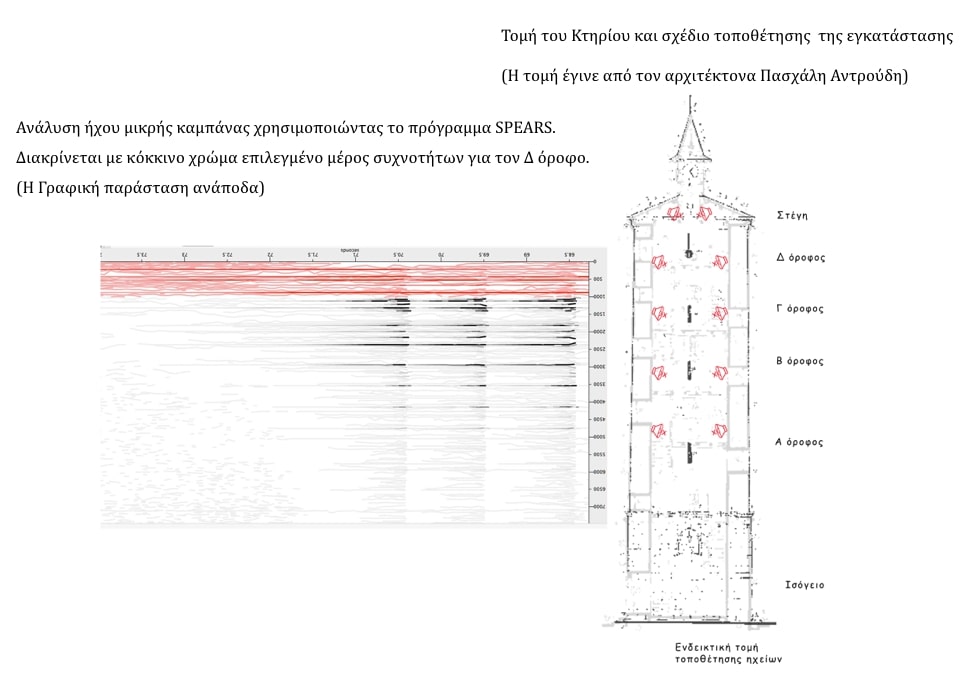Σύνοψη της Ομιλίας για το έργο στο 5ο Συνέδριο Ακουστικής Οικολογίας στη Καλαμάτα
(Ομιλιτές: Δημήτρης Μπάκας, Μαρία Τριανταφυλλίδου)
Ο πύργος ρολογιού των Γιαννιτσών οικοδομήθηκε το 1753 από τον
Σερίφ Αχμέτ Μπέη, απόγονο του ιδρυτή της πόλης, γαζή Εβρενός. Κατά
τηδιάρκεια της Οθωμανικής Περιόδου, παρήγαγε μέσω του χτύπου της
καμπάνας, την οθωμανική αντίληψη για το χρόνο επενδυόμενος με συμβολισμούς
και διαμορφώνοντας το ηχοτοπίο της πόλης. Με την κατάργηση της πρωτογενούς
χρήσης του ρολογιού, άρχισε να προσεγγίζεται αποκλειστικά σαν ένα
οθωμανικό οικοδόμημα και να εγγράφονται χρήσεις, γεγονότα και αντιλήψεις
του 20ου αιώνα. Μετά τις εργασίες αποκατάστασης (2007-2010) τέθηκε το
ζήτημα της επανάχρησης και ανοίγματος προςτο κοινό. Η πρόταση του Δημήτρη
Μπάκα για την οργάνωση Site Specific Art ήταν μια δομική προσθήκη που
επαναπροσδιόρισε την ηχητική λειτουργία. Ο καλλιτέχνης μέσα από την
οντολογική προσέγγιση της τέχνης αναζήτησε την ηχητική μνήμη και το λόγο
ύπαρξης του πύργου μετακινώντας την ταυτότητα από το τοπόσημο, στο ηχητικό
σήμα/ηχόσημο και από την τοπογραφία, στο ηχοτοπίο. Η ηχητική εγκατάσταση
μορφώνει μια χωρική κατανομή του φάσματος του ήχου μιας καμπάνας στους
ορόφους του μνημείου μεταμορφώνοντας το εσωτερικό σε μια γιγάντια καμπάνα
και σε έναν ηχοπερίπατο.Το Site Specific Art του Δημήτρη Μπάκα στον πύργο
ρολογιού των Γιαννιτσών είναι μια εικαστική επαναπροσέγγιση του οθωμανικού
συστήματος του χρόνου και η επανένταξη του μνημείου στη ζωή της σύγχρονης
πόλης με την ενσωμάτωση της πρωτογενούς λειτουργίας χωρίς
προθέσεις διαγραφής ή αναπαραγωγής.
Abstract from the presentation at the 5th Conference of Acoustic Ecology in Kalamata
(Paper/Talk: Dimitris Bakas and Maria triantafillidou)
The Clock Tower of Giannitsa was erected in 1753-4 by Serif Ahmed Bey, descendant of the city founder Gazi Evrenos Bey. During the Ottoman Period, It was producing through the bell sound the ottoman perception of time carrying symbolisms and forming the city soundscape. By the abolishment of the primordial use of the clock, it was exclusively perceived as an ottoman architectural structure where uses, incidensts, and perceptions of the 20th century were registered. After the completion of the restoration works (2007-2010), the issue of the monument re-usage and the opening to the public were arised. Dimitris Bakas proposal for the installation of a Site Specific Art was a fundamental addendum to the Tower that redefines its functionality. The artist, through an ontological art approach searched out for the sound memory and the clock tower’s raison d’être and redefined its identity from a landmark to the sound sign/soundmark, and from topography to the soundscape. Under this scope, the artist designed a sound installation, inside the tower, that its purpose is to create a spatial distribution of the spectrum of a bell sound on the floors. This creates a sound simulation of the interior of a bell, that can be experienced as a sort of soundwalk. The monument is this way is transformed into a giant bell. The Site Specific Art for the Giannitsa clock tower by Dimitris Bakas is a visual re-thinking of the ottoman time system and a reincorporation of the monument in contemporary city life by the integration of the primordial function with no intented deletion or reproduction.
Φωτογραφίες
Σχέδιο κατανομής του ήχου μέσω της εγκατάσταση με βάση τηςν ανάλυση φάσματος του ήχου καμπάνας




